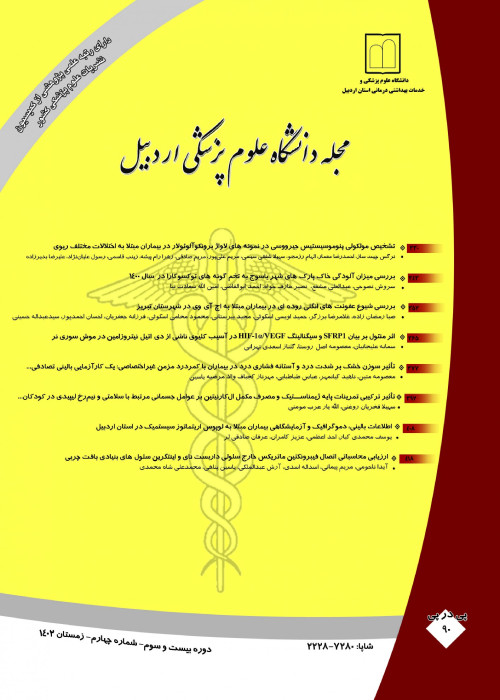Influence of the concentration, pH, temperature and pressure parameters on Arsenic removal from drinking water via reverse osmosis process
Abstract:
Background and Objectives
Arsenic is the third element of 5th Group of the periodic table and it is the twentieth rarest element in the earth's crust. This material has application in agriculture, livestock, medicine, electronics and metallurgy. It enters the environment from natural phenomena and human activities, causing pollution in it. Arsenic is a substance that is poisonous, cumulative, and an inhibitor of SH group enzymes. Several studies have identified significant correlation between high levels of Arsenic in drinking water and cancer in liver, nasal cavity, lungs, skin, bladder and kidney in men and women, and prostate in men. The present study was aimed to determin the impact of parameters affecting reverse osmosis membrane performance in Arsenic removal from drinking water.Methods
In this research, Arsenic removal was surveyed and tested through reverse osmosis membrane with spiral-wound module (model: 2521 TE, made in CSM Co. Korea). The used solution was prepared synthetically in the laboratory using sodium arsenate, and system performance was investigated under the influence of parameters such as arsenic concentration, pressure, pH and temperature of the input solution. In each case, the flux rate passing through the membrane and transverse velocity was measured. For each mode, after 30 minutes, desired samples were picked up, and then were tested with silver diethyldithiocarbamate method (Test No. 3500-As B, standard method).Results
The results of experiments and measurements showed that the parameters of concentration, pH, temperature and pressure in input solution are effective in reverse osmosis membrane performance (model TE 2521), and the increase or decrease in each parameter leads to changes in the system's efficiency and performance. The optimal conditions and performance of membrane under the influence of these parameters were defined as follows: pressure 190-210 psi, concentration 0.2-0.5 mg/L, temperature 25-30 0C, and pH = 6-8. Arsenic removal efficiency at the optimum system performance was determined at about 99-95 percent.Conclusion
According to the results and the high efficiency and acceptable performance, this approach is effective and can be applied as a method for Arsenic removal in areas with contaminated water.Language:
Persian
Published:
Journal of Ardabil University of Medical Sciences, Volume:10 Issue: 37, 2010
Page:
261
magiran.com/p816244
دانلود و مطالعه متن این مقاله با یکی از روشهای زیر امکان پذیر است:
اشتراک شخصی
با عضویت و پرداخت آنلاین حق اشتراک یکساله به مبلغ 1,390,000ريال میتوانید 70 عنوان مطلب دانلود کنید!
اشتراک سازمانی
به کتابخانه دانشگاه یا محل کار خود پیشنهاد کنید تا اشتراک سازمانی این پایگاه را برای دسترسی نامحدود همه کاربران به متن مطالب تهیه نمایند!
توجه!
- حق عضویت دریافتی صرف حمایت از نشریات عضو و نگهداری، تکمیل و توسعه مگیران میشود.
- پرداخت حق اشتراک و دانلود مقالات اجازه بازنشر آن در سایر رسانههای چاپی و دیجیتال را به کاربر نمیدهد.
In order to view content subscription is required
Personal subscription
Subscribe magiran.com for 70 € euros via PayPal and download 70 articles during a year.
Organization subscription
Please contact us to subscribe your university or library for unlimited access!


